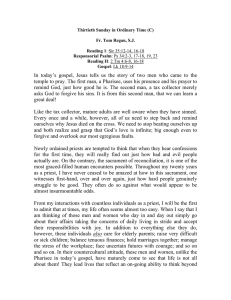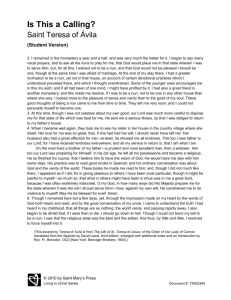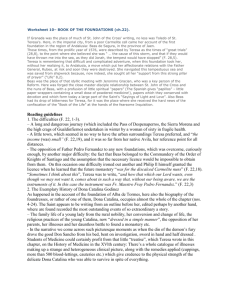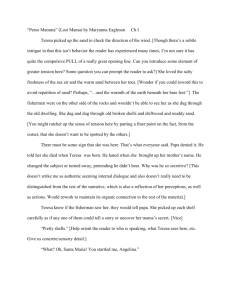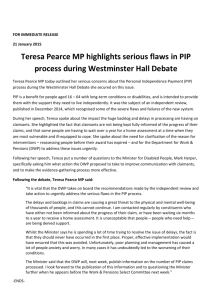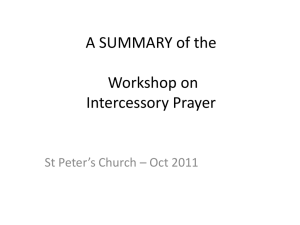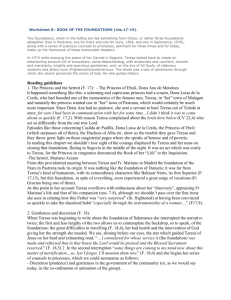Stage one Gardener goes to water the garden
advertisement
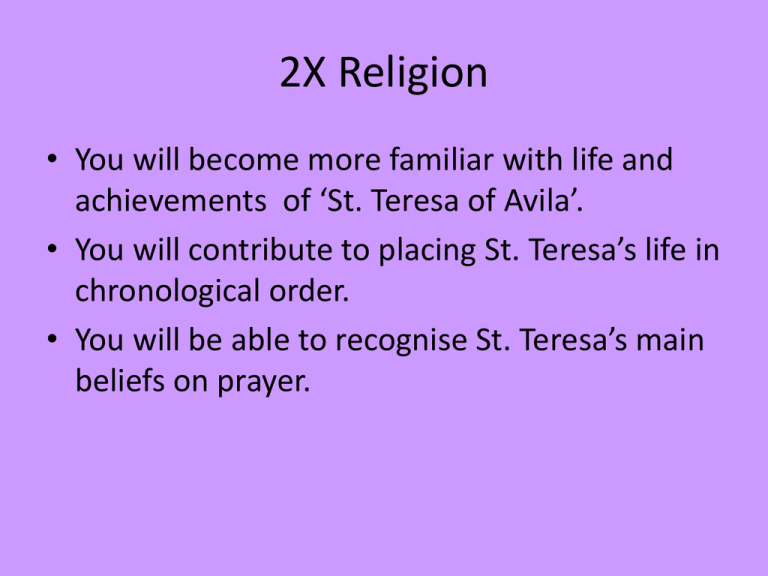
2X Religion • You will become more familiar with life and achievements of ‘St. Teresa of Avila’. • You will contribute to placing St. Teresa’s life in chronological order. • You will be able to recognise St. Teresa’s main beliefs on prayer. Born: 28th March 1515 Avila, Spain. Chronological order • 3 minutes • http://www.online-stopwatch.com/fullscreen-stopwatch/ • Video clip. Early life • Even as a young age, Teresa showed signs of piety. • Her childhood games revolved around pretending to be a nun living in the community. • As a young child she read stories of saints with her brother. • They were especially interested in the stories of martyrs. They wanted to become martyrs too, because this wasn’t possible they decided to become hermits. • Their uncle spoiled their plans when they spotted the children outside the city walls. • St. Teresa was sent to an Augustinian school to be educated at the age of fourteen. • About eighteen months later she became ill. She spent her convalescence reading the letters of St Jerome. • During this time she decided she wanted to become a nun. • Her father was opposed to the idea at first. • Teresa eventually ran away from home and secretly entered the Carmelite monastery. • She was twenty years old. St. Teresa’s life as a nun. • There were 150 nuns in the Carmelite order. • The lifestyle there was not as strict as Teresa would have liked. • Teresa again had to return home due to illness. • After four years she returned to the convent. • She had strong opinions about prayer and felt that prayer should be at the very centre of her life. • She felt that God was calling her to found different type of monastery where there was more of an emphasis on a simpler and quieter lifestyle. • After some initial opposition, St. Teresa founded a new monastery called the monastery of St. Joseph. • The sisters spent their time praying, gardening and caring for the poor. • They owned nothing and lived on donations they received in return for simple services like spinning wool and sewing. • St. Teresa went on to found sixteen other monasteries where men and women could follow this simple lifestyle. • Her feast day is on 15th October. Her contribution to prayer • At different stages in her life St Teresa preferred different types of prayer. • As a young girl she loved the rosary • As a young adult she found that vocal prayer brought her closer to God. • Later in life, she found that reading scriptures and focusing on nature reminded her of God’s presence. • In later life St. Teresa realized that contemplative prayer was very powerful. Contemplation St Teresa described prayer as moving through four stages. • • • • Stage one Gardener goes to water the garden with buckets of water (Person decides to pray) Stage two Gardener uses a water hose to water the garden (Still requires work, but requires less time to get the same job done. The job is easier, but is still being completed.) (Having firstly decided to pray the pray-er can now pray with ease. Is now less distracted) Stage Three The gardener waters the garden with running water from a stream. Just a small amount of work involved in directing the stream to the garden. The stream now does all of the hard work. (Prayer becomes more about what God does and less about what the pray-er does) Stage Four The gardener sits quietly and allows the rain to fall and water the garden. (Communication with God is now powerful and does not require any work. Contemplative prayer is about resting and being comfortable in God’s presence). Task: • Using the information you have learned, complete a Facebook profile. • You must pose as St. Teresa. • You must include key information about her life, and her beliefs on prayer. St. Teresa’s prayer (Bookmark) Let nothing disturb you Let nothing frighten you All things are passing way God never changes Patience obtains all things Whoever has God lacks nothing God alone suffices.
